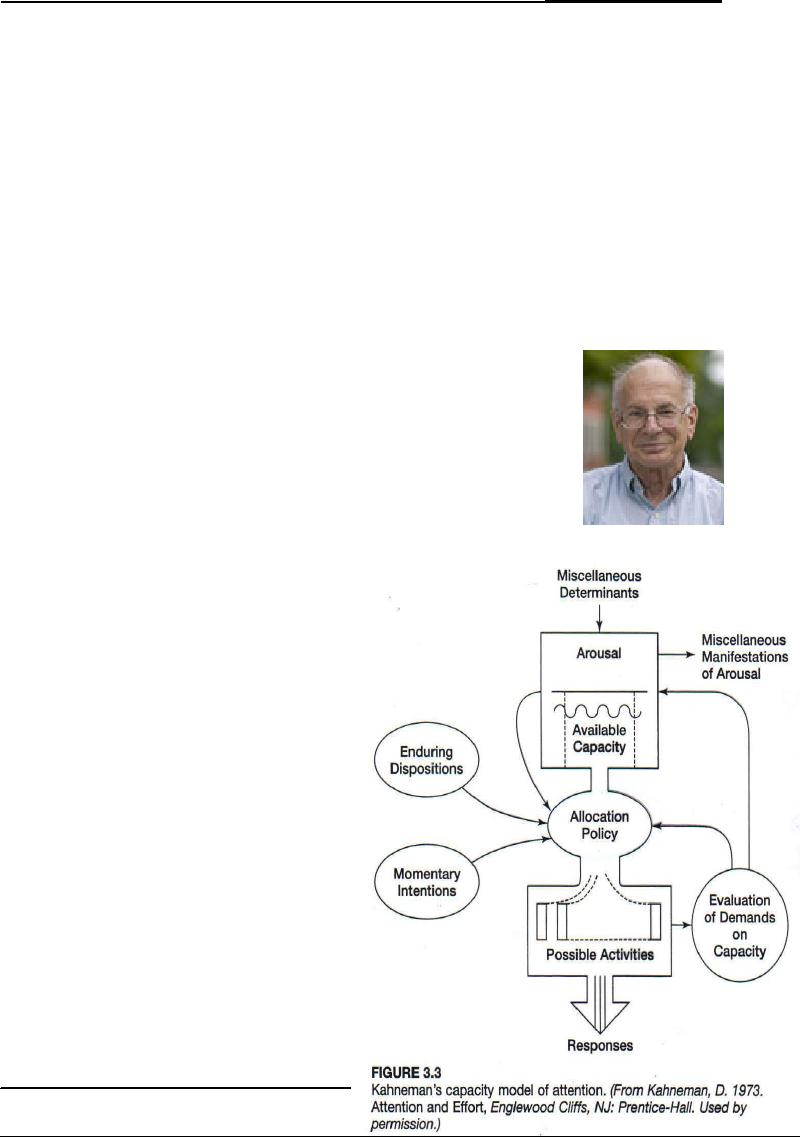 |

Cognitive
Psychology PSY 504
VU
Lesson
09
ATTENTION
(continued)
Capacity
Models
Psychologists
have become more interested
in capacity Demands of different
tasks (Kahneman,
1973).
Like there is information
coming in and then goes to
filter and only relevant
information is
selected.
Different tasks different
demands attention diverted to
one task to other task.
Tasks
require
mental effort. People may
have some control over
where the bottleneck occurs
(Johnston
&
Heinz, 1978)
Kahneman's
Capacity Model
Attention
and Effort" was a major
work of kahneman (Kahneman,
1973). He shifted the
focus
from
bottleneck to capacity. There is
flexibility in attention, like we
can change our attention
from
one
thing to other thing. There
is a lot of evidence that
our bottle neck is actually
adjustable and it
can
be move early to late. A
general limit on a person's
capacity to perform mental
work. A
person
has considerable control
over how this capacity is
allocated.
Daniel
Kahneman
He
has been doing his
work at Princeton University. He
has been a pioneer
of
cognitive psychology not
only in the area of
attention but on other
areas.
Kahneman's
Capacity Model
In
this model there are
many miscellaneous
determinants
that impact sensory
system.
Something
happens that trigger
arousal.
Arousal
means some activity starts.
Arousal
has
many manifestations. Available
capacity
of
attention will be allocated
depending on
the
state of arousals. So there is
allocation
policy.
Then there are
some possible
activities.
Like the amount of attention
is paid
on
a task. At the same time
there is a
feedback
loop. We evaluate how
much
attention
is needed for the task.
Then we
readjust
more capacity to that
task.
The
factors that have impact on
allocation
policy
are:
Arousal
A
physiological state that
influences the
distribution
of mental capacity in the
various
tasks.
Enduring
Disposition
An
automatic influence where
people direct
their
attention.
26

Cognitive
Psychology PSY 504
VU
Monetary
Intentions
A
conscious decision to allocate
attention to certain tasks or
aspects of the
environment.
Example:
World Trade
Centre
Boeing
707 flying in cloudy
weather, at an altitude 200
feet below the top of
the WTC was
reported
by the airport controller.
Alarm buzzed in the airport
control tower to signal the
danger.
The
controller radioed the crew
to turn around and climb up
to 3000 feet. The controller
was
monitoring
seven other planes at the
time. His attention was
diverted to other planes so he
could
not
pay attention to that plane.
So alarm diverted his
attention toward that
plane.
Bottleneck
vs. Capacity
Both
models predict that
simultaneous activities are
likely to interfere with
each other. They
attribute
the interference to different
causes.
Bottleneck:
according to
this model same mechanism
required to perform 2 incompatible
tasks.
It
is specific. It says same
mechanism id needed to those
tasks.
Capacity: Demands of 2
activities exceed available
capacity then there is
problem. It is non-
specific
to the task. Total demands
of the task, is an important
variable.
Both
kinds of interference occur
(specific and capacity,
early selection and
late
selection.)
Both
kinds of theories are
necessary.
Capacity
& Stage of Selection
All
experiments are showing
flexibility of attention. It means we
can divert our
attention
from one task to other
task.
These
are also showing an
interaction between bottleneck &
capacity theories
(Johnston
& Heinz, 1978). Listener
has control over the
location of the
bottleneck.
The
location can vary from
early mode of selection
(before recognition) to
late
mode
of selection (after semantic
analysis means meaning
analysis).
There
is a need to combine capacity
model and stage of
selection.
Multimode
Theory
A
theory that proposes that
people's intentions and the
demands of the task
determine the
information
processing stage at which
information is selected.
Demands
of task require greater
mental efforts. People's
intentions and the demands
of task
decide
where the attention is paid.
We select on the basis of
meanings if there are two
competing
tasks.
Early
Selection vs. Late
Selection
27

Cognitive
Psychology PSY 504
VU
According
to this theory both early
and late selection can
occur. Attention is flexible. We
can
move
our bottleneck and filter.
But there must be
interaction between bottleneck
and capacity.
We
can shift our bottleneck to
the low level in information
processing when we pay
attention to
the
physical properties of the
task. We have a capacity to
switch our bottle neck
from early to late
or
late to early. Late
selection will affect the
perception of primary message
because more
information
is selected about the
secondary task.
28
Table of Contents:
- INTRODUCTION:Historical Background
- THE INFORMATION PROCESSING APPROACH
- COGNITIVE NEUROPSYCHOLOGY:Brains of Dead People, The Neuron
- COGNITIVE NEUROPSYCHOLOGY (CONTINUED):The Eye, The visual pathway
- COGNITIVE PSYCHOLOGY (CONTINUED):Hubel & Wiesel, Sensory Memory
- VISUAL SENSORY MEMORY EXPERIMENTS (CONTINUED):Psychological Time
- ATTENTION:Single-mindedness, In Shadowing Paradigm, Attention and meaning
- ATTENTION (continued):Implications, Treisman’s Model, Norman’s Model
- ATTENTION (continued):Capacity Models, Arousal, Multimode Theory
- ATTENTION:Subsidiary Task, Capacity Theory, Reaction Time & Accuracy, Implications
- RECAP OF LAST LESSONS:AUTOMATICITY, Automatic Processing
- AUTOMATICITY (continued):Experiment, Implications, Task interference
- AUTOMATICITY (continued):Predicting flight performance, Thought suppression
- PATTERN RECOGNITION:Template Matching Models, Human flexibility
- PATTERN RECOGNITION:Implications, Phonemes, Voicing, Place of articulation
- PATTERN RECOGNITION (continued):Adaptation paradigm
- PATTERN RECOGNITION (continued):Gestalt Theory of Perception
- PATTERN RECOGNITION (continued):Queen Elizabeth’s vase, Palmer (1977)
- OBJECT PERCEPTION (continued):Segmentation, Recognition of object
- ATTENTION & PATTERN RECOGNITION:Word Superiority Effect
- PATTERN RECOGNITION (CONTINUED):Neural Networks, Patterns of connections
- PATTERN RECOGNITION (CONTINUED):Effects of Sentence Context
- MEMORY:Short Term Working Memory, Atkinson & Shiffrin Model
- MEMORY:Rate of forgetting, Size of memory set
- Memory:Activation in a network, Magic number 7, Chunking
- Memory:Chunking, Individual differences in chunking
- MEMORY:THE NATURE OF FORGETTING, Release from PI, Central Executive
- Memory:Atkinson & Shiffrin Model, Long Term Memory, Different kinds of LTM
- Memory:Spread of Activation, Associative Priming, Implications, More Priming
- Memory:Interference, The Critical Assumption, Limited capacity
- Memory:Interference, Historical Memories, Recall versus Recognition
- Memory:Are forgotten memories lost forever?
- Memory:Recognition of lost memories, Representation of knowledge
- Memory:Benefits of Categorization, Levels of Categories
- Memory:Prototype, Rosch and Colleagues, Experiments of Stephen Read
- Memory:Schema Theory, A European Solution, Generalization hierarchies
- Memory:Superset Schemas, Part hierarchy, Slots Have More Schemas
- MEMORY:Representation of knowledge (continued), Memory for stories
- Memory:Representation of knowledge, PQ4R Method, Elaboration
- Memory:Study Methods, Analyze Story Structure, Use Multiple Modalities
- Memory:Mental Imagery, More evidence, Kosslyn yet again, Image Comparison
- Mental Imagery:Eidetic Imagery, Eidetic Psychotherapy, Hot and cold imagery
- Language and thought:Productivity & Regularity, Linguistic Intuition
- Cognitive development:Assimilation, Accommodation, Stage Theory
- Cognitive Development:Gender Identity, Learning Mathematics, Sensory Memory